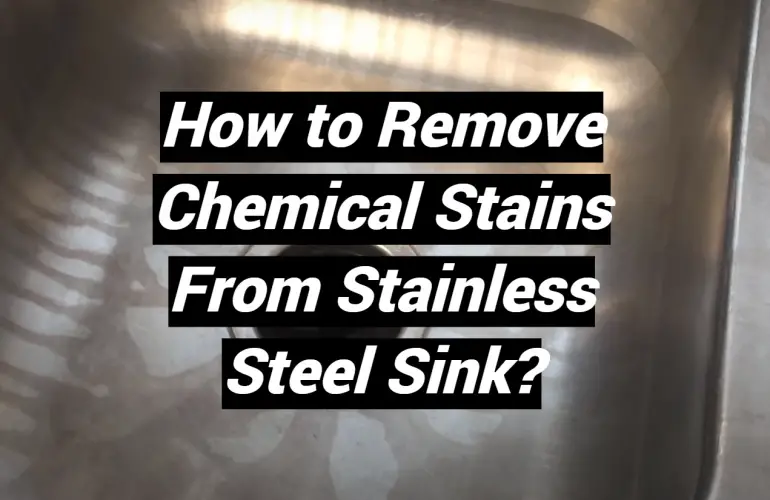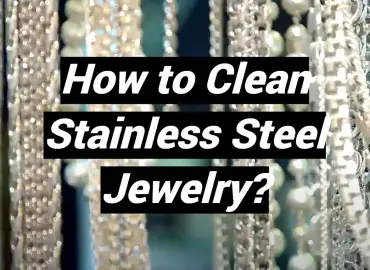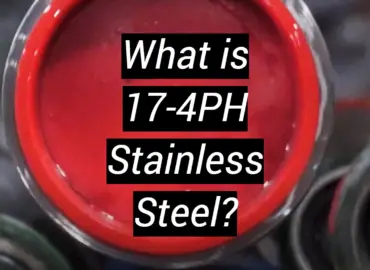If you have a stainless steel sink in your home, then you know that it can be a pain to keep clean. Chemical stains are the worst, and they seem to show up no matter how often you clean your sink. In this blog post, we will teach you how to remove chemical stains from stainless steel sinks using common household products. Follow these simple steps, and your sink will be looking good as new in no time!
What Is Stainless Steel?
Stainless steel is an alloy of iron, chromium and other metals. It is sometimes called “inox” steel (from the French word “inoxydable”) because it is resistant to corrosion. There are different grades and surface finishes of stainless steel produced to accommodate the environment in which the material will be used.
However, over time they may start to show signs of wear and tear. One common issue that can occur is the development of stains from chemicals such as cleaners or bleaches. While these products are safe to use on other surfaces, they can cause damage to stainless steel. [1]What Are The Benefits Of A Stainless Steel Sink?
A stainless steel sink is an excellent choice for the kitchen because it withstands wear and tear and is easy to maintain. Stainless steel is a corrosion and stain-resistant alloy made of iron, chromium, and nickel. It is also non-porous so it does not absorb dirt or bacteria.
What Are the Disadvantages of Stainless Steel Sinks?
However, stainless steel sinks can be susceptible to staining from certain chemicals.
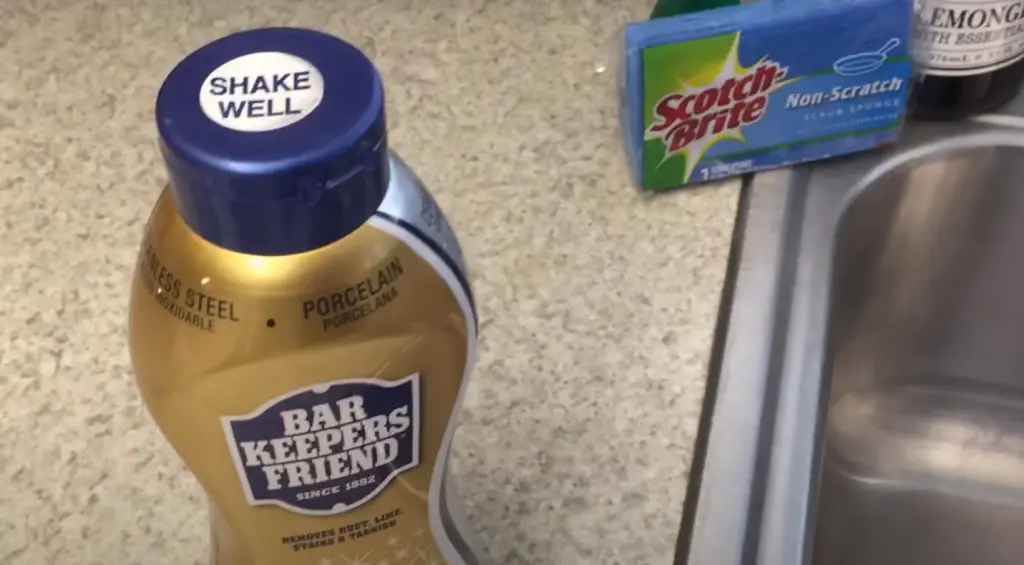
This is because the chromium in the alloy can react with certain chemicals to form achromic oxide, which is a black or brown substance.
Types Of Stains And Corrosion
Hard Water
This is the most common type of stainless steel sink stain and is usually caused by a buildup of minerals, such as calcium and magnesium, in the water. The stains are usually white and show up as spots or streaks. They can be challenging to get rid of. [2]
Acidic Foods
Acidic foods, such as lemons, tomatoes, and vinegar, can cause corrosion of the finish on your stainless steel sink. This type of corrosion appears as a dull, dark stain on the surface of the sink.
Rust
Rust stains can occur if your stainless steel sink is exposed to iron or other metals. These stains appear as reddish-brown spots on the surface of the sink and are often difficult to remove.
Chlorine And Chlorides
Chlorine and chlorides, such as salt, can cause pitting and corrosion of the stainless steel sink. These stains appear as small, dark spots on the surface of the sink.
Bimetallic Corrosion
Bimetallic corrosion, or the process of two dissimilar metals oxidizing when in contact with each other, is most commonly seen between materials like stainless steel and copper. This type of corrosion can cause staining and discoloration of the sink.
Acid Staining
Acid staining is a type of corrosion that occurs when acidic liquids, such as coffee or tea, come into contact with the stainless steel sink. This type of corrosion can cause staining and discoloration of the sink.
Iron Staining
Iron staining can occur if your stainless steel sink is exposed to iron or other metals. These stains appear as reddish-brown spots on the surface of the sink and are often difficult to remove. [3]
A General Stain Removal Procedure for Stainless Steel Sink
- Begin by cleaning the area with a mild detergent and water. If the stain is still visible, you can try using a non-abrasive cleaner or white vinegar.
Rinse the area with clean water and dry it off with a soft cloth. - If the stain is still present, you can try using a slightly abrasive cleaner like baking soda or comet. Make sure to rinse the area well and dry it off afterwards.
- For stubborn stains, you may need to use a stronger cleaner like CLR or Lime-A-Way. You should always test these cleaners on a small hidden area before using them on the entire stain.
- Once the stain is gone, you can protect the area by polishing it with a stainless steel cleaner and protector.
Stainless steel sinks are a common sight in many kitchens and bathrooms. They are durable and easy to clean, but they can still be susceptible to staining from certain materials. If you have a stainless steel sink that has been stained by chemicals, there are a few ways to remove the stains and keep your sink looking like new.
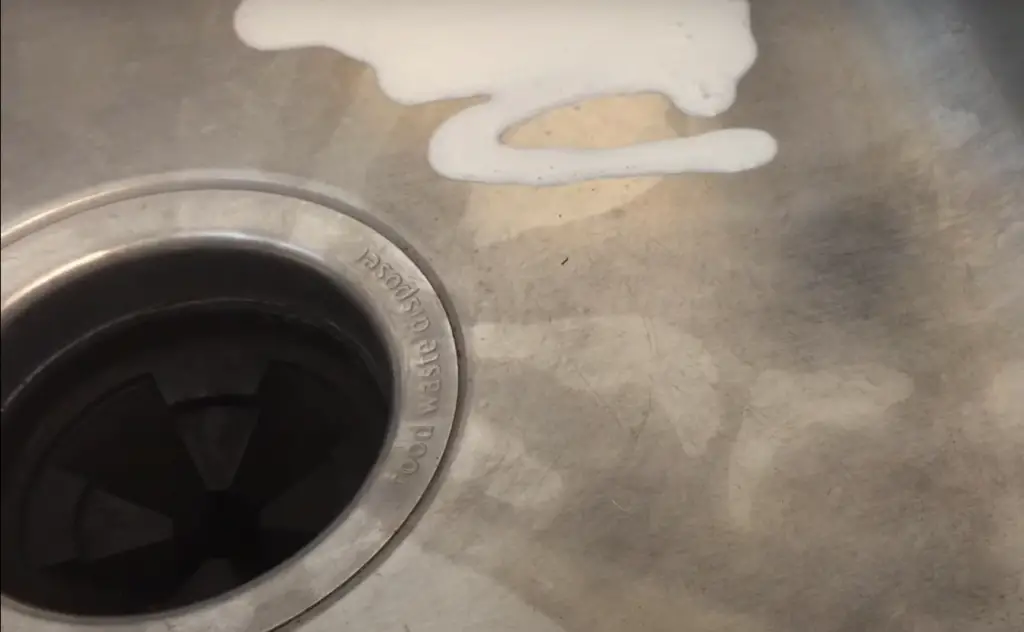
With any stain removal method, it is always best to test the solution on a small hidden area of the sink before using it on the entire stain. This will help to ensure that the solution does not damage the finish of your sink.
Getting Rid Of Calcium And Rust Stains
If your stainless steel sink is starting to show signs of rust or calcium buildup, you’ll need to take action to remove the stains. Fortunately, there are a few simple methods you can use to get rid of these unsightly blemishes.
One way to remove rust stains from stainless steel is to use a product called Bar Keepers Friend. This cleaner is specifically designed for removing rust and other tough stains from metal surfaces. Simply apply the cleaner to the stain and scrub it away with a soft cloth or sponge.
If your stainless steel sink has been stained by calcium deposits, you can try using vinegar to break down the buildup. Pour a small amount of vinegar onto the stain and let it sit for several minutes before scrubbing it away with a brush or sponge. You may need to repeat this process a few times to completely remove the calcium deposits.
Once you’ve removed the rust or calcium stains from your stainless steel sink, be sure to rinse the area well with water and dry it off with a soft cloth. This will help prevent new stains from forming in the future. [4]
For Hard-To-Remove Stains
Baking soda is a natural cleaning agent that can be used to remove hard-to-remove stains from stainless steel sinks. Pour a small amount of baking soda onto the stain and scrub it with a soft sponge. Rinse the sink with clean water and dry it with a soft cloth.
For Fresh Stains
Soak a clean cloth in warm water and vinegar solution. Place the cloth over the stain and let it sit for several minutes. Scrub the stain gently with the cloth until it disappears. Rinse the sink with clean water and dry it with a soft cloth.
For Stubborn Stains
Mix equal parts of baking soda and salt together to form a paste. Rub the paste onto the stain using a soft sponge. Rinse the sink with clean water and dry it with a soft cloth.
Vapor Cleansing Process
If you have a chemical stain on your stainless steel sink, the best way to remove it is through a process called vapor cleansing. This process uses high-pressure steam to remove the stain from the metal surface.
The first step in vapor cleansing is to apply a small amount of water to the stained area. Next, you will need to apply a generous amount of pressure to the water using a steam cleaner. The high-pressure steam will break down the chemical bonds that are holding the stain to the metal surface. After a few minutes, you should see the stain begin to lift off of the metal surface. Once the stain is removed, you can then rinse off the area with clean water.

Chemical etching is another method that can be used to remove chemical stains from stainless steel. This process involves using a strong acid to eat away at the stain. However, this method should only be used as a last resort, as it can damage the metal surface if not done correctly.
Alternative Methods To Remove Chemical Stains
If the chemical cleaner has not worked or if you are looking for alternative methods to remove the stains, here are a few things you can try:
Use Baking Soda
Baking soda is a natural cleaning agent that can be used to remove many types of stains, including chemical stains. To use this method, mix together equal parts baking soda and water to form a paste. Apply the paste to the stained area and scrub with a soft-bristled brush. Rinse away the paste with clean water and dry the area with a soft cloth.
Use Vinegar
Vinegar is another natural cleaning agent that can be used to remove chemical stains from stainless steel sinks. To use this method, mix together equal parts vinegar and water. Apply the mixture to the stained area and scrub with a soft-bristled brush. Gently rinse the mixture away with clean water and dry thoroughly with a soft cloth.
Use Lemon Juice
Lemon juice is another natural cleaning agent that can be used to remove chemical stains from stainless steel sinks.
Use the mixture on the stained area and scrub lightly with a soft-bristled brush. To remove the mixture, rinse with clean water and dry thoroughly with a soft cloth. [5]Use Cream of Tartar
Cream of tartar is another natural cleaning agent that can be used to remove chemical stains from stainless steel sinks. To use this method, mix together equal parts cream of tartar and water to form a paste. Apply the paste to the stained area and scrub lightly with a soft-bristled brush. Wash the area with clean water and dry completely using a soft cloth.
Use Rubbing Alcohol
Rubbing alcohol is another natural cleaning agent that can be used to remove chemical stains from stainless steel sinks. To use this method, apply rubbing alcohol directly to the stained area and scrub with a soft-bristled brush. Gently wash the area with cool water and dry it using a soft towel.
If you have any other tips or tricks on how to remove chemical stains from stainless steel sinks, please share them in the comments below!
Prevent Chemical Stains On Stainless Steel Sinks
To prevent chemical stains from setting on your stainless steel sink, always rinse the area with water immediately after using any cleaners or chemicals. You should also avoid letting any cleaner or chemical sit on the surface of the sink for an extended period of time.
Be sure to dry the area completely afterwards to prevent future staining.
If you have followed these preventive measures and still find yourself with a stubborn chemical stain, there are a few ways to remove it safely without damaging your sink.
FAQ
How do you remove chemical discoloration from stainless steel?
There are several ways to remove chemical staining from stainless steel. The most common method is to use a mild abrasive cleaner such as Bon Ami or Bar Keepers Friend. If the stain is more stubborn, you can try using a stronger cleanser such as CLR or Lime-A-Way. You may also need to use a nylon scrubbing pad to remove the stain. For hard water stains, you can use vinegar or lemon juice. Be sure to rinse the area well after cleaning and dry it with a soft cloth.
How do you remove acid stains from a stainless steel sink?
The best way to remove acid stains from stainless steel is to use a product specifically designed for that purpose. There are several brands on the market, such as Acid Magic and Iron OUT. You can also try using a paste made from baking soda and water. Apply the paste to the stain and scrub with a nylon brush. Rinse well and dry the area with a soft cloth.
How do you remove permanent stains from stainless steel?
There are a few ways that you can remove permanent stains from stainless steel.
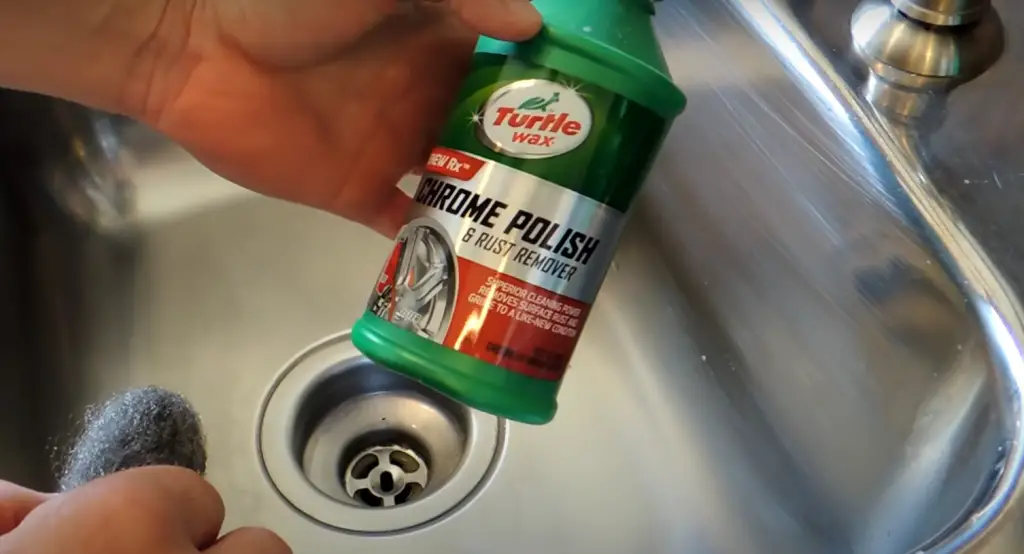
One way is to use a mild abrasive cleaner such as Bon Ami or Bar Keepers Friend. Another way is to use a vinegar and water solution. You can also try using baking soda and water paste. If the stain is still not removed, you may need to use a stronger cleaner such as CLR or Lime-A-Way.
How do you remove muriatic acid from a stainless steel sink?
If you have muriatic acid on your stainless steel sink, you will need to neutralize the acid first. You can do this by using baking soda and water paste. Once the acid is neutralized, you can then clean the area with a mild soap and water solution. You may also need to use a stronger cleaner such as CLR or Lime-A-Way to remove the stain.
Will vinegar harm stainless steel sink?
No, vinegar will not harm your stainless steel sink. In fact, vinegar is a natural cleaner that can be used to remove stains and dirt. However, you should always dilute the vinegar with water before using it on your sink. You should also avoid using vinegar on stainless steel that has a brushed finish.
Can I use bleach on my stainless steel sink?
You should avoid using bleach on your stainless steel sink. Bleach can damage the finish of your sink and may also cause staining. If you must use bleach to clean your sink, you should always dilute the bleach with water first. You should also rinse the area thoroughly with clean water after cleaning.
Does acid damage stainless steel?
Acid can damage the finish of your stainless steel sink. If you have acid on your sink, you will need to neutralize the acid first. You can do this by using baking soda and water paste. Once the acid is neutralized, you can then clean the area with a mild soap and water solution. If the stain does not come off with dish soap, you may have to use a more powerful cleaning solution such as CLR or Lime-A-Way.
Can you ruin a stainless steel sink?
It is possible to ruin a stainless steel sink. If you use harsh chemicals or abrasives on your sink, you can damage the finish and cause it to stain. To avoid ruining your sink, always use gentle cleaners and avoid scrubbing with abrasive pads or brushes.
If you do need to remove a tough stain, there are a few home remedies that can help. Baking soda is one of the most effective gentle cleaners for stainless steel. Simply sprinkle some baking soda on a damp cloth and rub it in a circular motion over the stained area. Rinse with water and dry with a soft cloth.
Vinegar is another natural cleaner that can be used on stainless steel. Combine equal parts vinegar and water in a spray bottle and mist the solution onto the stain. Let it sit for a few minutes, then scrub with a nylon brush. Rinse with water and dry with a soft cloth.
If you have a tougher stain, you can make a paste out of baking soda and vinegar. Combine equal parts baking soda and vinegar in a bowl and stir until it forms a paste. Rub the paste into the stain using a damp cloth. For best results, rinse with water and dry softly with a cloth.
You can also try using commercial stainless steel cleaners. These cleaners are designed specifically for use on stainless steel and can be effective at removing tough stains. Follow the instructions on the cleaner to ensure that you are using it correctly. If you are unsure about which cleaner to use, consult with a professional. In most cases, it is best to avoid using harsh chemicals on your stainless steel sink. These chemicals can damage the finish and cause staining. If you must use a chemical cleaner, always test it in an inconspicuous area first to make sure it will not damage the finish.
What are some alternatives to stainless steel?
There are a few other materials that can be used for kitchen sinks including:
- Titanium
- Copper
- Fireclay
- Composite granite
- Solid surface materials like Corian or HiMacs
Each of these materials has its own unique set of pros and cons that need to be considered before making a final decision. For example, titanium is a very strong and durable material but it is also one of the most expensive options.
Copper is another durable option that can develop a beautiful patina over time, but it is also susceptible to scratches and dents.
Fireclay is a material that has been used for centuries and is known for its durability and beauty.
Composite granite is a newer material on the market that is made from a blend of granite and acrylic. It is a very strong and durable material that is also heat resistant. Solid surface materials are man-made materials that can mimic the look of stone or other natural materials. They are non-porous and easy to clean but they can be scratched or damaged if they are not properly cared for.
How to maintain stainless steel?
Stainless steel is one of the most popular materials used in modern kitchen sinks. It is prized for its durability and low maintenance requirements. However, it is not immune to staining from certain chemicals. If you have chemical stains on your stainless steel sink, there are a few ways to remove them.
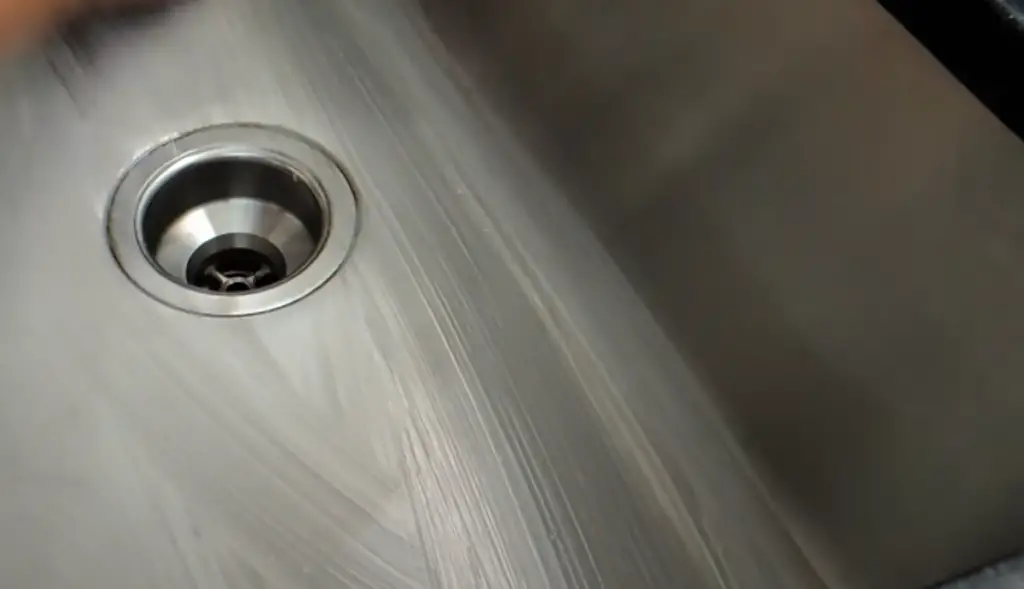
One way to remove chemical stains from stainless steel is to use a mild abrasive cleaner. This can be something as simple as baking soda or vinegar. Wet the area with the stain and then sprinkle on the baking soda or vinegar. Use a clean cloth to scrub at the stain gently until it comes off. Rinse well with water afterwards.
Another way to remove chemical stains from stainless steel is to use a stronger cleaning agent. There are many options available at the store, but you should always read the labels carefully to make sure it is safe for stainless steel. Apply the cleaner to the stain and scrub it off with a clean cloth. Rinse well with water afterwards.
If the above methods do not work, you may need to resort to more heavy-duty measures. You can sand the area with fine-grit sandpaper or use a chemical stripper. These methods will remove the top layer of the stainless steel, so they should only be used as a last resort.
Useful Video: How To Clean Chemical Stained Stainless Steel Kitchen Sink
Conclusion
When it comes to cleaning your stainless steel sink, there are a few things you need to keep in mind. First, always use gentle cleaners and avoid harsh chemicals. Second, make sure to rinse the sink thoroughly after cleaning to remove any residue. Finally, drying the sink with a soft cloth will help to prevent water spots. By following these simple tips, you can keep your stainless steel sink looking like new for years to come.
References:
- https://www.thyssenkrupp-materials.co.uk/stainless-steel-composition.html
- https://www.cleanipedia.com/gb/kitchen-cleaning/clean-stainless-steel-sinks-cookware-appliances.html
- https://www.hunker.com/13719470/how-to-remove-chemical-stains-from-a-stainless-steel-sink
- https://www.diamondbackplumbing.com/residential/bathroom-plumbing/removing-rust-stains-and-calcium-buildup/
- https://home.howstuffworks.com/home-improvement/household-hints-tips/cleaning-organizing/10-ways-to-clean-the-kitchen-with-lemon-juice.htm

